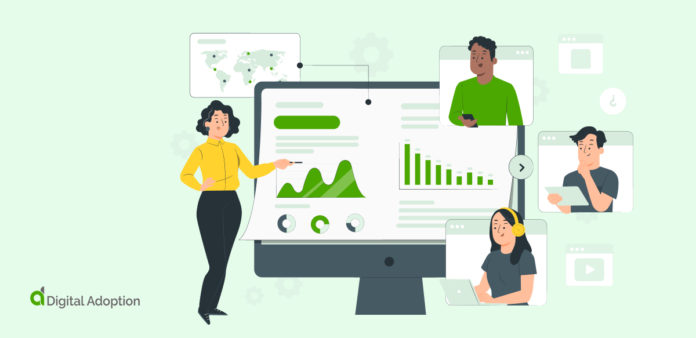What Is Digital Transformation?
Digital Transformation (DX) refers to integrating digital technology to achieve organizational growth. Organizations apply digital technology to increase business process efficiency, manage workflows, and boost employee productivity. Digital technology also has a significant impact on customer-facing services too, such as customer support.
While digital technologies have the potential to transform an organization, technology alone isn’t enough. A comprehensive digital transformation strategy is the only way an organization can achieve its desired results. Digital transformation roadmap is essential for successful organizational change.
A digital transformation strategy is a step-by-step plan for implementing new technologies across the business. Every digital transformation strategy focuses on how technology can add business value to specific areas. For example, automation platforms can streamline the customer experience. Customers can access information and receive help through online chatbots, reducing the support staff’s burden.
Why Is Digital Transformation Important?
Digital transformation fundamentally changes how an organization operates. Companies can use digital technologies to shift to new business models, offer customers improved services, and reach new consumer bases.
According to Gartner’s 2021 Digital Business Acceleration Survey, ‘65% of executives reported accelerating the pace of their digital business initiatives. Business leaders are opening their eyes to the possibilities for growth through digital transformation.
Digitalization enhances data collection, meaning companies get better customer insights. It leads to higher profits, increased return on investments, boosts employee productivity, and makes a business more agile. Agility is crucial to surviving disruptions in the digital age.
Digital technology helps companies adapt to evolving customer demands and trends. A successful digital transformation strategy encourages a digital-first company culture. Businesses help their employees embrace new technologies and convey the benefits.
What Does Digital Transformation Look Like In 2022?
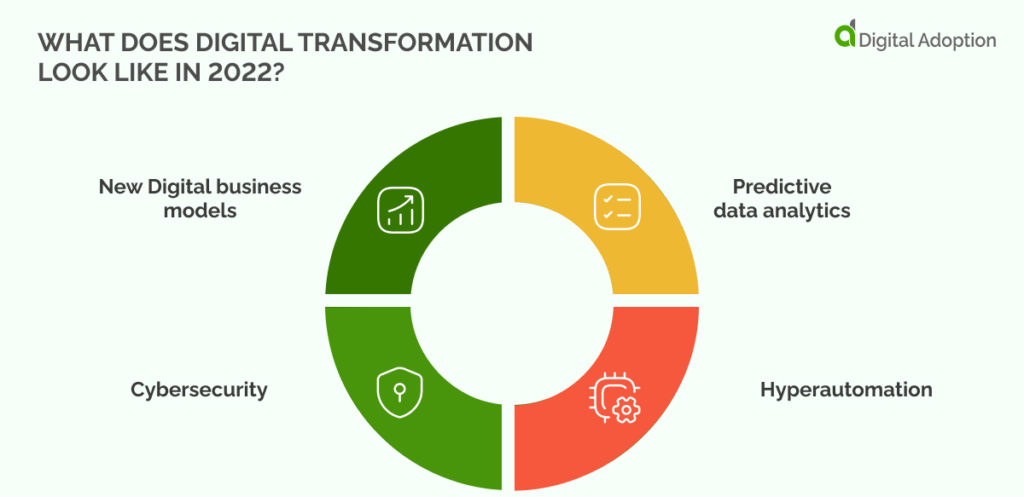
Digital transformation is a high priority for ambitious companies in 2022. The pandemic forced digital transformation leaders to increase their efforts. Technologies such as artificial intelligence, cloud computing, machine learning, and other digital tools are at the forefront of global digital transformation initiatives.
Here are the digital transformation trends you can expect to see in 2022.
New Digital business models
Digitalization creates opportunities for new business models. Companies shift business models to reach a new consumer base and strengthen customer relationships. For example, automation platforms provide new ways for customers to access information online or seek support through online chatbots. Many companies have adapted their business models to cater to modern customer expectations.
Netflix famously shifted to a digital business model, transforming from a mail-order DVD service to a global streaming giant. Many companies followed in Netflix’s footsteps by shifting to digital. Embracing digital tools is vital for any business to gain a competitive advantage in the digital age.
Predictive data analytics
As data collection technology improves, companies can get better insights into their customers. For example, the insurance industry uses customer data to assess risk levels and provide more accurate claims. Predictive data analytics helps companies meet evolving customer expectations.
Companies will also battle with the privacy paradox. Customers gravitate towards companies that offer a more personalized customer experience. Companies have to collect more customer insights. At the same, customers are wary about giving over too much information. Businesses in 2022 must find a balance between personalization and privacy.
Cybersecurity
Organizations become more susceptible to hacking as they improve their data management capabilities. Companies will prioritize cybersecurity in the next few years to protect customer data from cyber attacks and breaches. This involves investing in cybersecurity technology and training employees to manage data correctly.
Having the best defenses in place to protect company databases is essential. Effectively handling customer data builds trust and leads to better customer interactions. In the event of a cybersecurity attack, companies need a crisis plan in place to mitigate the damage to their customers.
Hyperautomation
Hyperautomation is a new development in automation technology and a rising digital transformation trend in 2022. Hyperautomation makes automation even more effective. It uses digital technologies like machine learning, artificial intelligence, and robotic process automation. Organizations use these tools to analyze data on different business processes and find new ways to improve them.
Automation reduces employee workload, boosts productivity and performance, and optimizes business processes. Automation also streamlines the customer experience through digital platforms. Customer expectations have changed over the past decade. Now customers expect seamless online platforms to manage their information and get in contact with customer support.
How To Get Started On Your Digital Transformation Journey?
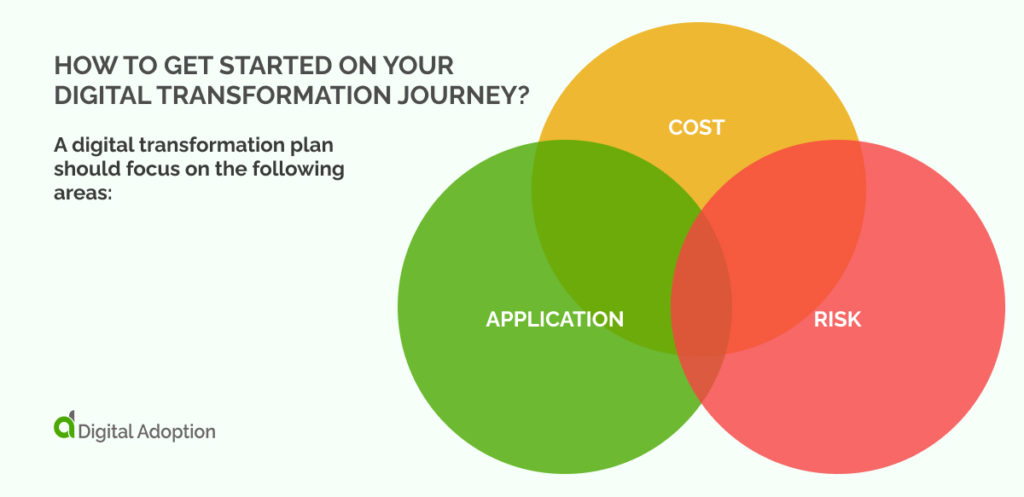
Many business leaders feel the need to update their company’s digital technology capabilities, especially after the pandemic shifted everyone’s focus to online orders and remote work. Now, businesses view digital transformation as a requirement. But how do you begin your transformation journey?
Before investing in expensive digital solutions, you need a comprehensive plan. The success of any organization’s digital transformation strategy depends on its program. Without a comprehensive plan, you risk your transformation falling apart at the first hurdle.
A digital transformation plan should focus on the following areas:
- Cost. How will you keep costs low while getting maximum value from technology investments?
- Risk. Identify potential risks early to reduce the likelihood and mitigate any impact.
- Application. Evaluate the application of new technology. Is your digital transformation initiative addressing redundancy, criticality, and business value?

What Are The Three Classes Of Digital Transformation?
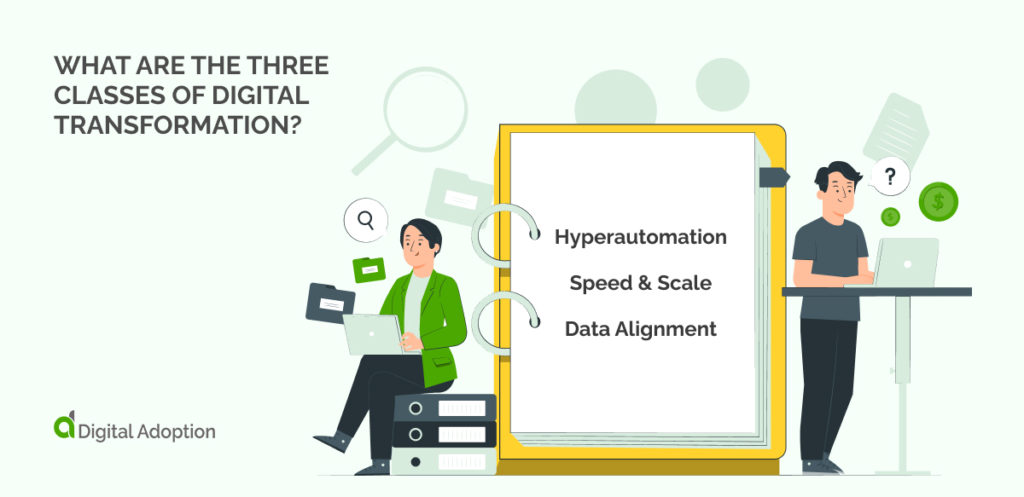
The digital transformation process can be broken down into three main components:
Strategy
Creating a comprehensive strategy is the most important aspect of any digital transformation initiative. The first step involves assessing your company’s current technological capabilities and asking how they can improve. Take a targeted integration approach to ensure technology investments don’t go to waste.
Your strategy should contain realistic and achievable goals. Employees must understand business goals, too, so they can see the direction the company is heading in. A successful digital transformation must outline a plan for collaboration between executives and employees.
Collecting regular feedback from employees using a feedback mechanism like a digital adoption platform is essential. This will help your organization make necessary adjustments based on what works and what doesn’t.
Speed & Scale
Companies struggle to scale up and accelerate the digital transformation process effectively. Finding cost-effective digital solutions that can grow alongside the company is challenging. The problem often lies in organizational structure.
To achieve scalability, organizations must nurture a digital-first culture in which employees actively seek improved ways of work. Successful digital transformations require engagement from all employees. Otherwise, change initiatives become superficial and don’t have any meaningful impact on the business.
Achieving enterprise-wide digital transformation means setting out a clear mission. As McKinsey describes in a recent report, the answer to how to scale your digital transformation is relatively straightforward. ‘To truly change the company, organizations need to reshape project portfolios into clearly defined missions that link directly to corporate strategy.’ This means that employees should know how their responsibilities intersect with business objectives.
Data Alignment
Aligning data and strategy is crucial to achieving full digital maturity. This means collecting the right customer data and knowing how to leverage that data. More industries are increasing their capacity for data collection. However, collecting large amounts of data isn’t enough.
The key is hiring the right specialists and teams to translate data into actionable insights. Companies align data with digital transformation efforts to get the most value from digital technologies. You must identify the most valuable data assets and create a system for reusability.
Without this approach, data analytics become siloed, leading to inefficient processes. Focus on reusable data assets for increased speed and scalability. This way, you can get the most out of data analytics for optimal customer insights.
How Has The COVID-19 Pandemic Impacted Digital Transformation?

After the Covid-19 pandemic, many organizations began embracing digital transformation. Global trends indicate that customers expect companies to offer digital services as more people become tech-savvy.
During the pandemic, there was a massive increase in online shopping. Business leaders invested heavily in automation platforms to improve their online customer experiences. These digital platforms created a seamless interaction, allowing customers to receive support from online chatbots, view all their account information online, and order products remotely at the click of a button.
Even after the return to in-store shopping, customers still flock to online services for convenience. This is just one of many examples of digital transformation creating lasting change across industries.
Other trends within the workplace indicate a shift in employee attitudes to work. The pandemic caused a surge in mental health issues related to work-life balance. Companies have taken different approaches to integrate workers back into the office. But Gartner’s research on 9 Future of Work Trends Post Covid-19 shows that ‘75% of hybrid or remote knowledge workers [agree] their expectations for working flexibly have increased.’
Many employees feel a sense of betrayal because they don’t want to return to the office. Employers make the wrong decision by forcing staff back to the office when they aren’t ready. Looking past the pandemic, it’s clear that employers will need to prioritize a strong support network for their workers.
What Is A Digital Transformation Framework?
A digital transformation framework is a set of guidelines for achieving meaningful organizational change. Frameworks are like blueprints that digital transformation leaders use to help companies thrive in the digital era.
A digital transformation framework provides a proven method for leveraging new technologies to provide better services for customers. Frameworks are beneficial for organizations that are unfamiliar with digital transformations.
They include key performance indicators, standards, and checklists that digital businesses use to secure their place in the digital economy.
How To Create A Robust Digital Transformation Framework
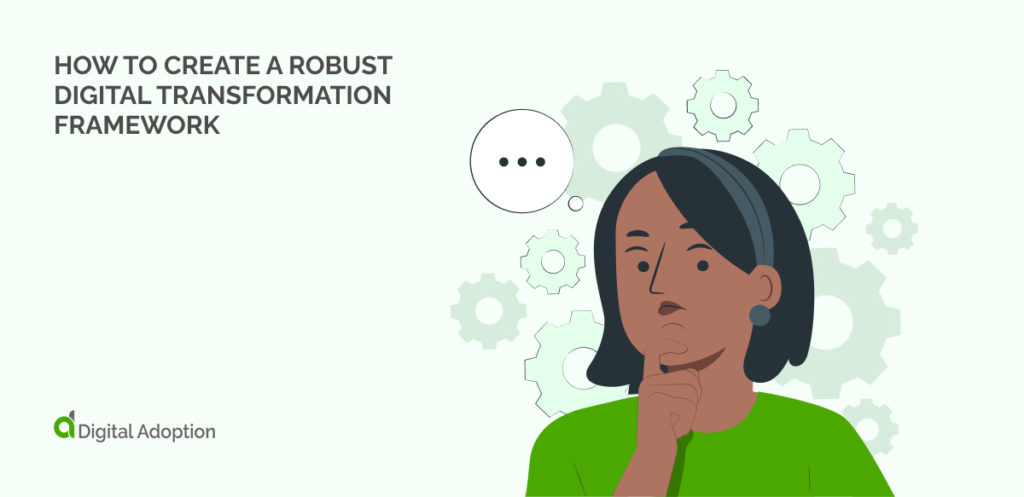
Many companies get distracted by modern technologies during their digital transformation journeys. They neglect the human side of change and fail to encourage a digital-first culture. The best digital transformation frameworks focus on achieving customer value by enhancing business operations.
It’s up to business leaders to find the right solution by focusing on the right problems. The first step to creating a robust framework is identifying weak areas of the organization. Ask how technology will integrate with and improve business functions. Find a framework that guides your company through each crucial stage, including conceptualization, planning, communication, and technology investment choices.
A digital transformation framework isn’t the only tool that improves a business’ technology strategy. Many organizations hire a Chief Digital Officer to enhance digital initiatives. Their role is to leverage emerging technologies like artificial intelligence, digital data, cloud computing, and others to achieve strategic objectives.
Culture & Digital Transformation: Seeing Business Through A New Lens
How can you ensure your digital transformation efforts lead to better business outcomes? The answer lies in the intersection between culture and digital transformation.
Many digital transformation initiatives fail because business leaders neglect the impact of change on their employees. People guide organizational change, and without adequate support, employees won’t engage with new ways of work. This leads to a poor return on technology investments and wasted time.
Organizational culture affects a company’s ability to adapt to digital disruption in the future. After the COVID-19 pandemic, it’s clear that agility is an essential business trait for modern organizations. Companies must focus on changing culture to gain a competitive advantage in a constantly changing environment.
But how can business leaders engage employees in transformational initiatives?
5 Factors That Incentivize Digital Change
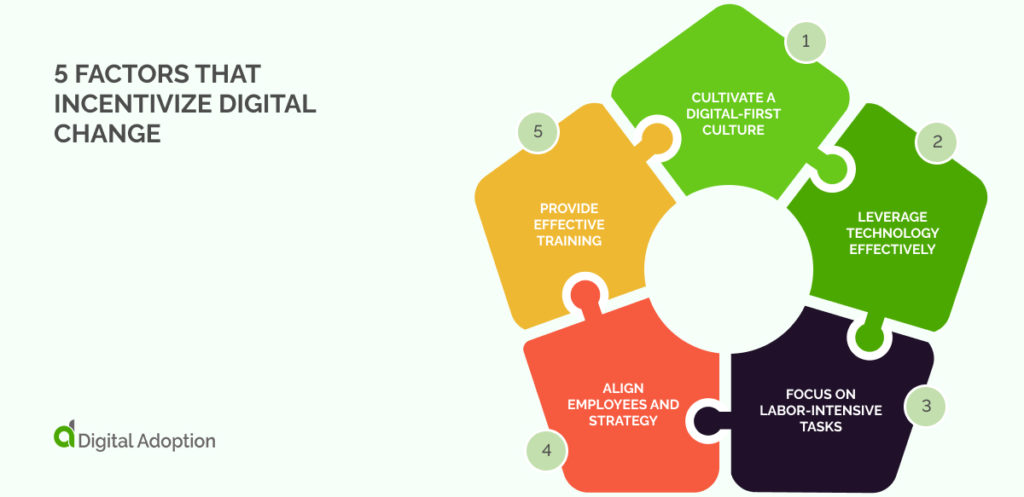
Digital transformations are complex processes consisting of many moving parts. Business leaders must focus on the people side of change to see results. This concept is known as change management. Change management is a set of best practices for guiding employees through organizational transformations.
1. Cultivate a Digital-First Culture
Resistance is a natural part of any change initiative. Instead of pushing back, employers should plan for resistance by encouraging cultural change. It’s not about getting over a hurdle at a time. It’s about enabling organizational change by shifting attitudes to digital technology.
Helping employees see change as a good thing means communicating the benefits of digital technology. Digital transformation will enhance workflow, make their jobs more rewarding, and improve their performance.
2. Leverage Technology Effectively
Getting the most out of technology goes beyond simply investing in new software and hoping it sticks. It’s essential to focus on the user experience. Consider how each employee will interact with new technology. Is the software intuitive? Does the technology enable seamless collaboration? Will employees require consistent training?
You get to the core of your technology strategy by addressing these issues. Workers determine the success of digital solutions. Source the best technology that fits the needs of your workforce.
3. Focus on Labor-Intensive Tasks
Improving business processes is often the main focus of digital transformations. But many organizations neglect small and repetitive tasks that end up wasting a lot of resources. Focus on activities that take up most of your employees’ time. Automating repetitive and simple tasks will free up labor and resources for more critical tasks. Automation also helps employees understand how digital transformation impacts them positively.
4. Align Employees and Strategy
The priority of any digital transformation project should be to improve employee experiences. Not only will digital technology improve productivity, but it will also boost overall worker satisfaction.
When creating a transformation strategy, ensure that any proposed changes will improve work for employees. This will ensure your employees become digital advocates and embrace future change. Aligning employees and strategy is a crucial component of change management.
5. Provide Effective Training
Many companies conduct a comprehensive training program during their onboarding and early adoption stages of their transformation initiative. But they often make the mistake of stopping or slowing down training once employees begin using new technology.
Often this leads to delayed resistance further down the line. Employees feel incompetent and don’t typically seek out help when learning something new. It’s crucial to provide ongoing training.
A great way to improve training is using a digital adoption platform (DAP). A DAP is software that integrates with other software to guide users through tasks. A DAP also streamlines the training process by collecting feedback on employee progress.
Key DX Trends Moving Into 2023
As organizations rebuild after the disruption caused by the pandemic, they look to 2023 for potential new investments. 2023 will be an excellent opportunity to accelerate enterprise digital transformation.
Here are some key trends to watch out for:
Sustainability and DX
Companies will look for new ways to combine sustainability projects with digital transformation initiatives. In 2023 sustainability will be the core focus, enabling innovation and delivering more business value.
A rise in digital platforms
Organizations have already begun leveraging digital platforms for an improved customer experience. This trend is set to accelerate in 2023, with many businesses adapting their value chains to meet the demands of new markets and ecosystems.
Reinventing business models
An increasing number of organizations are overhauling legacy systems to reshape their business operations. They incorporate technologies like artificial intelligence, machine learning, and cloud computing to optimize business operations. Digital innovations will drive more organizational reinventions than ever before.
4 Key Areas Of Enterprise Digital Transformation
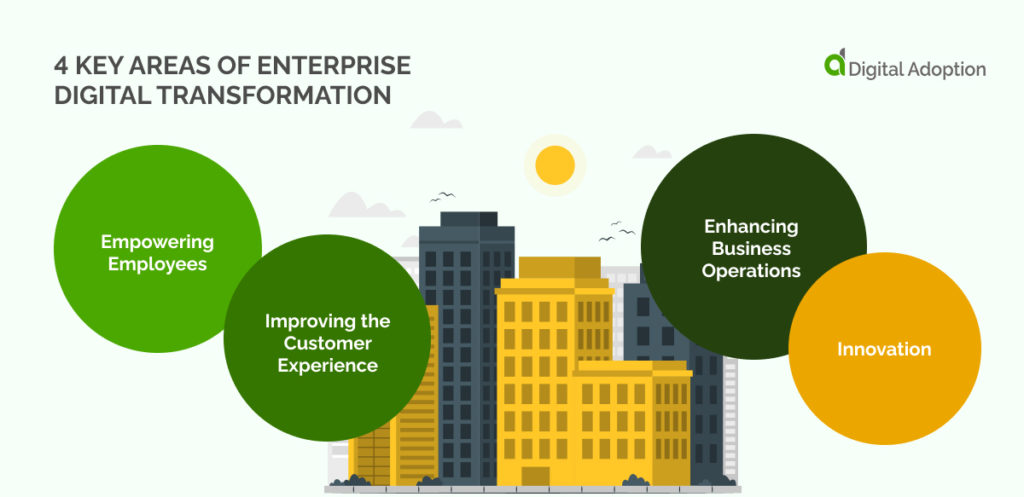
Every change leader has a different approach to digital transformation. However, many agree that digital transformation consists of four key areas. Enabling enterprise digital transformation requires a holistic approach, targeting all areas simultaneously.
Empowering Employees
A business strategy is only effective if everyone contributes to achieving desired outcomes. Empowering employees means motivating them to adopt new ways of working and providing them with the necessary skills to thrive in a digital landscape.
Improving the Customer Experience
Improving internal processes always leads to a better customer experience. This involves integrating digital platforms to respond more effectively to customer requests. In the digital age, tech-savvy customers expect a certain standard of digital proficiency from the brands they interact with.
Enhancing Business Operations
The purpose of digital technology is to increase efficiency. Your business strategy should identify areas of improvement and prioritize those areas when introducing new software. Enhancing business operations makes your business a well-oiled machine. If a business wants to adapt to disruption, digital transformation must be a priority.
Innovation
Digital transformation leads to business innovation. It opens the door to new business models, reinvention, new domains, and new ways to expand the business. Replacing legacy technology is a top priority for companies looking for new ways to innovate.
What Roles Drive Digital Transformation Projects?
Creating the right team of talent will determine the success of your digital transformation project. From IT experts to customer service specialists, which are the best roles to prioritize?
Change Managers
Digital transformation significantly impacts the status quo and often leads to employee resistance. To address the problem, your company needs the expertise of a change manager. Change managers are experienced in leading transformations and affecting positive growth. They take a targeted approach to affecting change, enabling personalized training and support.
Customer Experience Experts
Every digital transformation project should lead to an improved customer experience transformation. Their role is to optimize, measure, and drive effective customer experience strategies. They work with data analysts to retrieve essential customer insights. They focus on emerging market trends, customer expectations, and ways to impact revenue growth.
Digital Product Managers
A digital product manager is responsible for leading the production of digital products to market success. These products include apps, software tools, and other digital solutions. The role of a digital product manager involves delivering products through digital channels to improve the user experience.
Cloud Security Specialist
Securing a cloud-based solution is much more complex than handling your current data servers and requires the input of a cloud security specialist. Your organization remains vulnerable to breaches and attacks without the right cloud security talent.
What Digital Technologies Drive Digital Transformation?
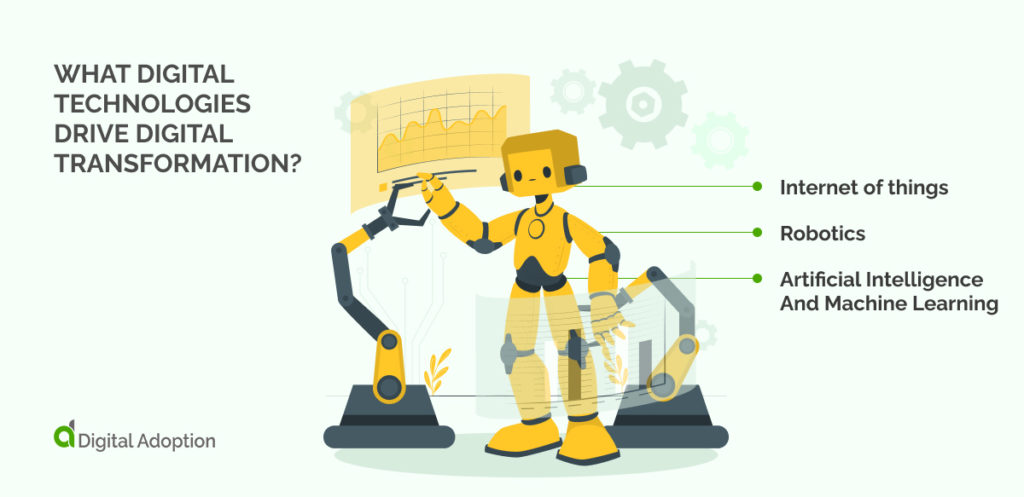
Digital technologies are at the core of digital transformation. Investing in smart technology is a complex process that requires a targeted approach. Business leaders must know how each technology impacts specific business areas to achieve desired results.
Here are some emerging technologies currently driving digital transformation:
Internet of things
The internet of things refers to a network of connected systems that collect and share information. This includes physical devices that contain software, sensors, or processing abilities, like mobile devices. The internet of things has become an invaluable source of data. The insurance industry, for example, collects more accurate data from a customer’s mobile device to improve claims processing.
Robotics
Companies use robotics to digitize simple and repetitive tasks. Robotics free up staff and resources for more critical business tasks. When combined with other new and emerging technologies, like artificial intelligence, robotics can enhance efficiency, improve productivity, and lead to a better user experience.
Artificial Intelligence And Machine Learning
Artificial intelligence exists in almost all smart technologies, from smart devices to natural language processors. Businesses use artificial intelligence to automate processes, make better business decisions, and provide improved online platforms for customers.
Machine learning is a type of artificial intelligence that mimics human learning to increase accuracy. It gains valuable insights from data and algorithms to help make predictions and perform actions without the need for human input.
How Can I Gauge ROI On Digital Transformation?
Many organizations fail to track the progress of their digital transformation effectively. Gauging a return on investment (ROI) is more than recording profit. To determine the success of technology investments, you must also look at employee engagement.
How satisfied are your employees using new technologies? Creating a feedback system is necessary to understand how employees feel about the change initiative. This will show your current digital solution’s effectiveness and highlight future improvement areas.
Another way to gauge ROI is by conducting a cross-benefit digital transformation analysis. For example, how much money has your company saved by implementing online chatbots? How effectively can your organization meet its business goals? Measuring success is a crucial component of digital transformation. It ensures that the process can continue and the benefits of digitalization are lasting.
Why Are Businesses Seeking Digital Transformation Strategies More Than Ever?
The level of enterprise digital transformation is at an all-time high. There are several reasons for this rise, but many experts believe the pandemic was a major accelerating force for most business leaders.
The unprecedented effects of the pandemic ultimately shifted attitudes to work for many employees. For the first time, remote work was a real possibility, and digitalization played a big part in making it work. Organizations realize that disruptions can occur anytime, and preparing is not always possible.
However, not enough organizations are actively crafting business strategies around future trends. They don’t have a robust system for detecting trends and disruptions. A recent Gartner survey shows that ‘only 38% of organizations have a formal process for this type of trendspotting.’ This research shows there’s still a long way to go before businesses adopt the right attitude to managing disruptions.
Digitization VS Digitalization Vs. Digital Transformation
Many business leaders use the terms digitization, digitalization, and digital transformation interchangeably, which can be confusing. But what does each term mean, and how do they differ?
Digitization
Digitization refers to the process of creating a digital representation of a physical object. For example, scanning a paper document to save it as a digital document. This can be useful during manufacturing to convert mechanical measurements into digital ones.
Digitalization
Digitalization refers to introducing digital technology within an environment or system. Businesses utilize digital technologies and digital data to enhance internal business processes. Digitalization reduces labor costs and boosts productivity and efficiency. Digitalization takes an existing process that requires human input and makes it a software-driven process.
Digital Transformation
Digital transformation is a business-wide transformation project that uses digitalization to achieve business growth. Any digital transformation initiative aims to change business processes by introducing digital technologies. This process differs from digitization and digitalization because it involves a wider-scope business strategy to change how the business operates using digital solutions.
CIO Digital Transformation Initiatives Guide: Everything You Need To Know
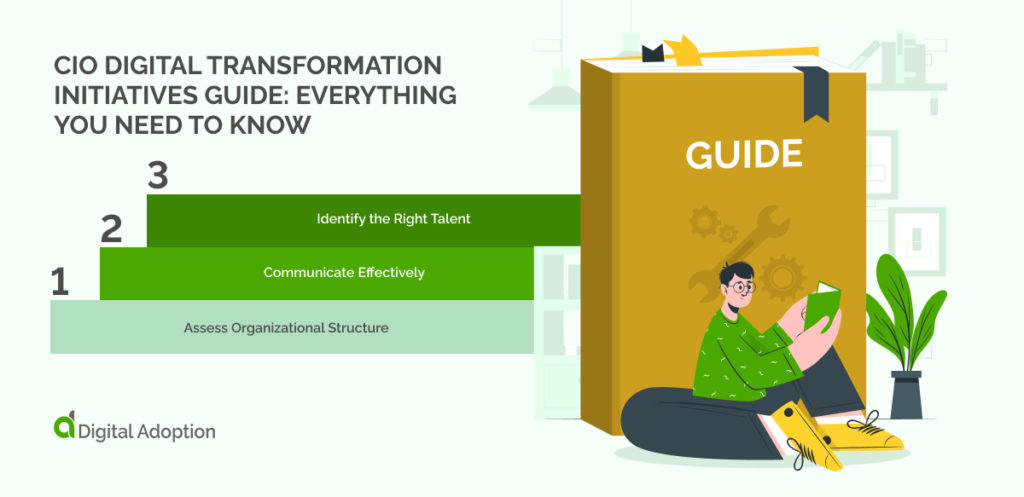
What should Chief Information Officers know when crafting the best digital transformation initiative? The role of a CIO comes with a lot of responsibility. They ultimately guide the entire digital transformation process, and it’s up to them to ensure their company’s strategy is effective.
Here are some essential tips for creating the most effective initiative.
1. Assess Organizational Structure
The first step to planning a winning strategy is to assess problem areas. Identifying weak points early on is a great way to avoid problems down the line. CIOs must be naturally reflective and analytical. Outside of assessing current technology capabilities, CIOs must analyze the organizational structure. They should focus on how the business fosters collaboration, the business culture, and attitudes to change.
2. Communicate Effectively
The best way to motivate the workforce is to tell a compelling transformation story. All successful CIOs are storytellers at heart, capable of convincing employees that digitalization is fundamentally transformative. The role of the CIO also requires communicating with executives to ensure buy-in on key technology investments.
3. Identify the Right Talent
A practical CIO understands that success depends on finding the right talent. Delegating key roles to influential team members relieves pressure from top management. When looking for the right talent, ask yourself, what skills are required to affect change? Will you train existing employees or hire new talent with the necessary expertise? Whether hiring IT specialists or customer experience experts, finding the right talent is vital to achieving desired results.
How DX Empowers People To Learn In New Ways
Digital transformation essentially gives your employees a new set of digital skills. These skills are becoming more valuable and sought after in a digital world. Empowering employees to learn is also an essential part of any digital transformation. If your employees aren’t learning, your organization won’t transform.
Employees often resist the unfamiliar, especially when it comes to training. Business leaders have found a solution to training through digital adoption platforms. Many organizations are still asking how digital adoption platforms increase technology adoption rates.
These platforms integrate with chosen software to guide employees through the training process. They enable a personalized approach to training, tailoring materials to the needs of individuals. Training becomes less about mastering digital tools and more about developing as an employee.
Creating A Playground For The Workforce Of Tomorrow
When business leaders think about improving the workplace, they often don’t consider the term ‘playground.’ Associations with childishness are hard to escape, but perhaps a playground is precisely what today’s employees need the most.
As organizations push for digital transformation, employees are under a lot of pressure to change. As a result of the two-year pandemic, the workforce lacks motivation and enthusiasm for any more change. Increasing employee engagement requires a new approach to workplace culture.
A big part of making work more enjoyable is to tackle the areas employees usually dislike the most. Perhaps the most significant of these areas is training. Digital transformation requires ongoing training throughout the process and after it ends. This deters a lot of employees.
Digital adoption platforms are a great way to make training more accessible and enjoyable. Adapting to employees’ learning styles is essential for addressing the concerns of tomorrow’s workforce. The future of the workplace is a more inclusive, considerate environment where employees can continuously learn in ways that fit them.
Digital Transformation Strategy Trends For 2023
Looking forward to 2023 can help change leaders prepare for potential disruptions caused by future trends. Here are some key strategy trends for next year:
Democratization of Innovation
As digital technologies become more accessible, we’ll see an increase in the democratization of innovation. This means the users of digital tools can innovate for themselves. Instead of relying on manufacturers, users will determine changes that better fit their needs.
The user-centric innovation process is an alternative to the traditional approach to development. It will change how organizations create digital transformation strategies. Employees will feel more involved in digital transformation efforts as they hold more of a stake in the outcome.
The Expanded Cloud
In 2023, CIOs will focus on the cloud to accelerate digital transformation. Companies that embrace the cloud achieve faster innovation, bringing more value to the market quicker than their competitors. 2023 will be the year that many CIOs prioritize cloud integration to get the most value. Organizations will target specific business domains where cloud computing has the most impact.
Real-Time Data Processing
Many experts agree that real-time data is the driving force behind enterprise digital transformation success. Real-time data processing is vital for improving business efficiency through automation. Compared to standard data, real-time data is more resilient and available. It often leads to better insights and improved performance. CIOs will prioritize real-time data processing to optimize employee workloads and automate critical business operations.

